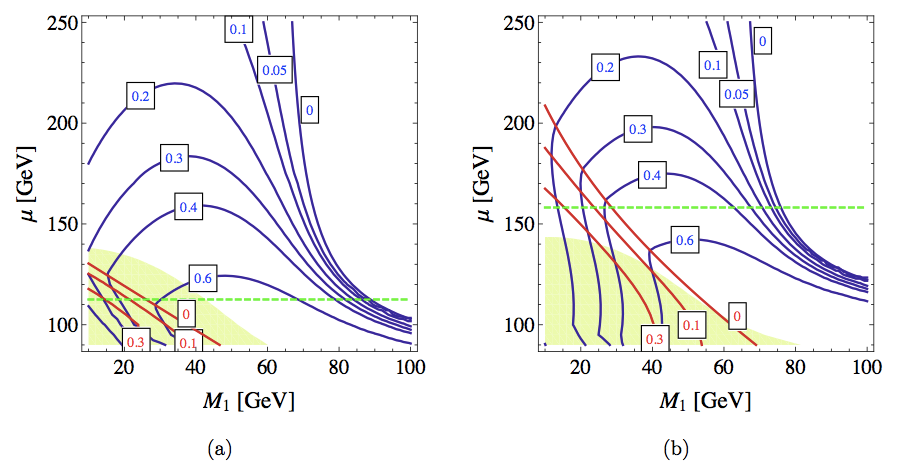In the framework of the Minimal Supersymmetric Standard Model (MSSM), the Higgs sector has been extensively studied in the light of the recent Higgs discovery. In particular a Higgs at around 125 GeV with SM-like properties can be realized in the decoupling limit where the additional scalars and pseudoscalars are heavy (ma,H,H± >~300 GeV). In this regime, exotic decays of the type h→ A0 Z, h→ HH, h→ A0A0, h→ H± W are kinematically forbidden (here A0 denotes the CP-odd scalar).1 In general, the regime mA ≤ mh/2 is highly constrained. This is due to the fact that the masses of the H, A0, and H± scalars of the MSSM are closely tied to one another. In particular, at the tree level mH±2=mA2+mW2, leading to a charged Higgs boson already excluded by LEP searches, for mA <~60 GeV. Additional Higgs exotic decays could be realized if some of the sparticles are lighter than the Higgs boson. In the MSSM with R-parity, this possibility is however very constrained by LEP and LHC searches. In particular, assuming a LEP bound at around 100 GeV for electrically charged sparticles, the only possible Higgs exotic decays, in the framework of the MSSM, are to sneutrinos or to neutralinos.2 However, in view of the LEP lower bound on the masses of the left handed sleptons, which are related through SU(2) symmetry to the sneutrino masses, the decay to sneutrinos are generically kinematically closed.
 |
Figure 1: Branching ratios of the Higgs into neutralinos: Br(h→χ1χ1) and Br(h→χ1χ2) are shown in blue and red, respectively. The yellow region is the region excluded by the LEP bound on the Z invisible width. The region below the dashed green line is the region with a lightest chargino below the LEP bound of ∼ 100 GeV. The input parameters are tanβ = 10 and M2=300 GeV (left), M2=150 GeV ( right).
The decay of the Higgs into neutralinos h→ χiχj is therefore typically the only accessible decay (here, as elsewhere, we suppress the superscript "0" on neutralinos to streamline notation). This decay mode is most easily realized in models with non-universal gaugino masses, for which the universality relation M1 ∼ [(M2)/2] ∼ [(M3)/7] at the electroweak scale is relaxed, allowing light LSPs while still satisfying the LEP and LHC bounds on chargino and gluino masses. As neutralinos which couple to the Higgs boson also typically couple to the Z, the main constraint on Higgs decays to neutralinos comes from the precise LEP measurements of the invisible and total widths of the Z boson, for mχi+mχj < mZ. However, as Fig. 1 shows, for mainly bino LSPs, it is possible to accommodate a sizable branching ratio for the decay h→ χ1χ1 while still maintaining compatibility with the LEP Z measurements (see also [7,8,9,10] for recent studies). The parameter space for which h→ χ1χ2 is open is presently strongly constrained by both LEP Z measurements (the yellow region in Fig. 1 is the region excluded by the LEP measurement of the Z invisible width) and chargino and neutralino searches at LEP and, especially, at the LHC (see e.g. [11]).
In summary, with the present constraints, the MSSM generally can only provide for Higgs decays into neutralinos. These neutralinos may either be detector-stable, in which case the Higgs decay is invisible (as discussed here), or, in models with gauge-mediated supersymmetry breaking, they may decay within the detector to photon-gravitino pairs [12] (as studied here). Higgs decays to other sparticles or to other (pseudo-)scalars in the extended MSSM Higgs sector are now strongly constrained by the LEP and LHC experiments.
References
- [1]K. Hagiwara, J. S. Lee, and J. Nakamura, Properties of 125 GeV Higgs boson in non-decoupling MSSM scenarios, JHEP 1210 (2012) 002, [arXiv:1207.0802].
- [2]M. Drees, A Supersymmetric Explanation of the Excess of Higgs-Like Events at the LHC and at LEP, Phys.Rev. D86 (2012) 115018, [arXiv:1210.6507].
- [3]P. Bechtle, S. Heinemeyer, O. Stal, T. Stefaniak, G. Weiglein, et. al., MSSM Interpretations of the LHC Discovery: Light or Heavy Higgs?, Eur.Phys.J. C73 (2013) 2354, [arXiv:1211.1955].
- [4]T. Han, T. Li, S. Su, and L.-T. Wang, Non-Decoupling MSSM Higgs Sector and Light Superpartners, [ arXiv:1306.3229].
- [5]G. Barenboim, C. Bosch, M.L.López-Ibañez, and O. Vives, Eviction of a 125 GeV "heavy"-Higgs from the MSSM, JHEP 1311 (2013) 051, [arXiv:1307.5973].
- [6]B. Batell, C. E. M. Wagner, and L.-T. Wang, Constraints on a Very Light Sbottom, [arXiv:1312.2590].
- [7]D. Albornoz Vasquez, G. Belanger, R. Godbole, and A. Pukhov, The Higgs boson in the MSSM in light of the LHC, Phys.Rev. D85 (2012) 115013, [arXiv:1112.2200].
- [8]N. Desai, B. Mukhopadhyaya, and S. Niyogi, Constraints on Invisible Higgs Decay in MSSM in the Light of Diphoton Rates from the LHC, [arXiv:1202.5190].
- [9]H. K. Dreiner, J. S. Kim, and O. Lebedev, First LHC Constraints on Neutralinos, Phys.Lett. B715 (2012) 199-202, [arXiv:1206.3096].
- [10]B. Ananthanarayan, J. Lahiri, P. Pandita, and M. Patra, Invisible decays of the lightest Higgs boson in supersymmetric models, Physical Review D 87, 115021 (2013) [ arXiv:1306.1291].
- [11]ATLAS collaboration, Search for direct production of charginos, neutralinos and sleptons in final states with two leptons and missing transverse momentum in pp collisions at sqrt s= 8 TeV with the ATLAS detector, JHEP 1405 (2014) 071, [arXiv:1403.5294].
- [12]J. D. Mason, D. E. Morrissey, and D. Poland, Higgs Boson Decays to Neutralinos in Low-Scale Gauge Mediation, Phys.Rev. D80 (2009) 115015, [arXiv:0909.3523].
Footnotes:
1SM-like Higgs bosons can also be achieved in a corner of parameter space where the additional scalar and pseudoscalars are lighter than mh (see for example [1,2,3]). Low energy flavor observables like b→ s γ, however, set important constraints on this region of parameter space [4,5]. Furthermore, the decays of the SM-like Higgs into lighter scalars are still not kinematically accessible. 2Light sbottoms are another possibility, but this is now almost entirely ruled out [6].File translated from TEX by TTH, version 4.03. On 15 Dec 2013, 22:20.